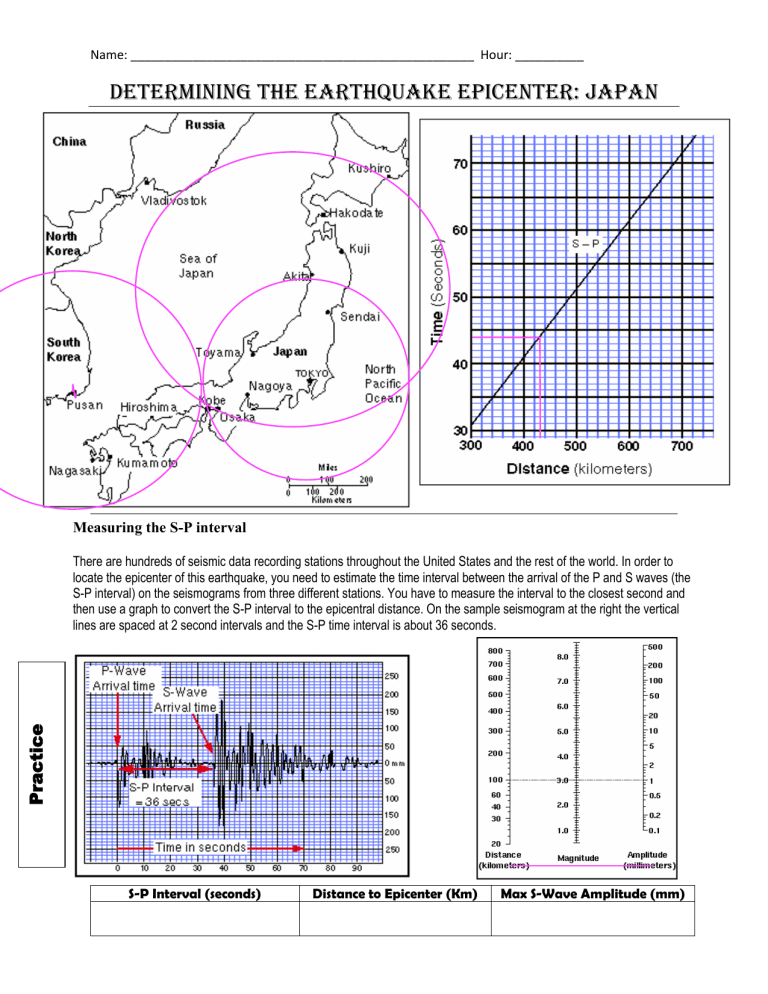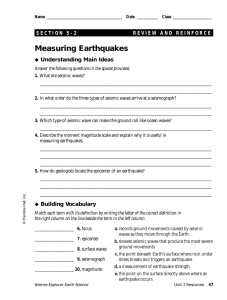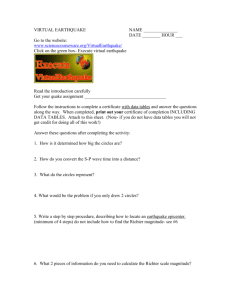
Name: __________________________________________________ Hour: __________ Determining the Earthquake Epicenter: Japan Measuring the S-P interval Practice There are hundreds of seismic data recording stations throughout the United States and the rest of the world. In order to locate the epicenter of this earthquake, you need to estimate the time interval between the arrival of the P and S waves (the S-P interval) on the seismograms from three different stations. You have to measure the interval to the closest second and then use a graph to convert the S-P interval to the epicentral distance. On the sample seismogram at the right the vertical lines are spaced at 2 second intervals and the S-P time interval is about 36 seconds. S-P Interval (seconds) Distance to Epicenter (Km) Max S-Wave Amplitude (mm) S-P Interval (seconds) Max S-Wave Amplitude (mm) 540km 75mm Pusan 56 seconds Distance to Epicenter (Km) S-P Interval (seconds) Max S-Wave Amplitude (mm) 430 km Tokyo 44 seconds Distance to Epicenter (Km) Distance to Epicenter (Km) Max S-Wave Amplitude (mm) Akita S-P Interval (seconds) My estimate for the Richter magnitude of this earthquake Seismic Deformation When an earthquake fault ruptures, it causes two types of deformation: static; and dynamic. Static deformation is the permanent displacement of the ground due to the event. The earthquake cycle progresses from a fault that is not under stress, to a stressed fault as the plate tectonic motions driving the fault slowly proceed, to rupture during an earthquake and a newly-relaxed but deformed state. Typically, someone will build a straight reference line such as a road, railroad, pole line, or fence line across the fault while it is in the pre-rupture stressed state. After the earthquake, the formerly straight line is distorted into a shape having increasing displacement near the fault, a process known as elastic rebound. Seismic Waves The second type of deformation, dynamic motions, are essentially sound waves radiated from the earthquake as it ruptures. While most of the plate-tectonic energy driving fault ruptures is taken up by static deformation, up to 10% may dissipate immediately in the form of seismic waves. The mechanical properties of the rocks that seismic waves travel through quickly organize the waves into two types. Compressional waves, also known as primary or P waves, travel fastest, at speeds between 1.5 and 8 kilometers per second in the Earth's crust. Shear waves, also known as secondary or S waves, travel more slowly, usually at 60% to 70% of the speed of P waves. P waves shake the ground in the direction they are propagating, while S waves shake perpendicularly or transverse to the direction of propagation. Although wave speeds vary by a factor of ten or more in the Earth, the ratio between the average speeds of a P wave and of its following S wave is quite constant. This fact enables seismologists to simply time the delay between the arrival of the P wave and the arrival of the S wave to get a quick and reasonably accurate estimate of the distance of the earthquake from the observation station. Just multiply the S-minus-P (S-P) time, in seconds, by the factor 8 km/s to get the approximate distance in kilometers. The dynamic, transient seismic waves from any substantial earthquake will propagate all around and entirely through the Earth. Given a sensitive enough detector, it is possible to record the seismic waves from even minor events occurring anywhere in the world at any other location on the globe. Nuclear test-ban treaties in effect today rely on our ability to detect a nuclear explosion anywhere equivalent to an earthquake as small as Richter Magnitude 3.5. What is Richter Magnitude? Seismologists use a Magnitude scale to express the seismic energy released by each earthquake. Here are the typical effects of earthquakes in various magnitude ranges: Earthquake Severity Richter Magnitudes Earthquake Effects Less than 3.5 Generally not felt, but recorded. 3.5-5.4 Often felt, but rarely causes damage. Under 6.0 At most slight damage to well-designed buildings. Can cause major damage to poorly constructed buildings over small regions. 6.1-6.9 Can be destructive in areas up to about 100 kilometers across where people live. 7.0-7.9 Major earthquake. Can cause serious damage over larger areas. 8 or greater Great earthquake. Can cause serious damage in areas several hundred kilometers across. One of Dr. Charles F. Richter's most valuable contributions was to recognize that the seismic waves radiated by all earthquakes can provide good estimates of their magnitudes. He collected the recordings of seismic waves from a large number of earthquakes, and developed a calibrated system of measuring them for magnitude. Richter showed that, the larger the intrinsic energy of the earthquake, the larger the amplitude of ground motion at a given distance. He calibrated his scale of magnitudes using measured maximum amplitudes of shear waves on seismometers particularly sensitive to shear waves with periods of about one second. The records had to be obtained from a specific kind of instrument, called a Wood-Anderson seismograph. Although his work was originally calibrated only for these specific seismometers, and only for earthquakes in southern California, seismologists have developed scale factors to extend Richter's magnitude scale to many other types of measurements on all types of seismometers, all over the world. In fact, magnitude estimates have been made for thousands of Moon-quakes and for two quakes on Mars. The diagram below demonstrates how to use Richter's original method to measure a seismogram for a magnitude estimate in Southern California:






